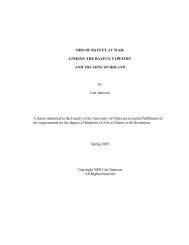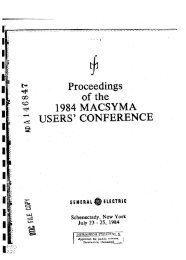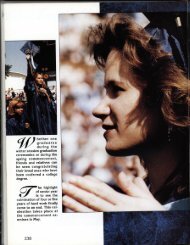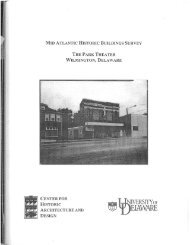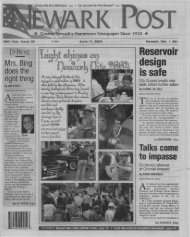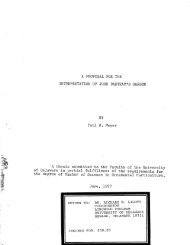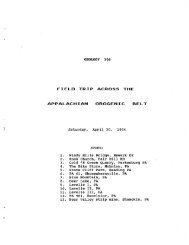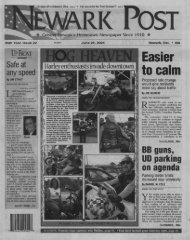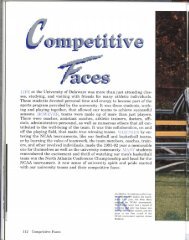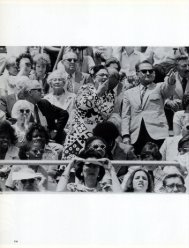Newark, DE 19711 - University of Delaware Library Institutional ...
Newark, DE 19711 - University of Delaware Library Institutional ...
Newark, DE 19711 - University of Delaware Library Institutional ...
You also want an ePaper? Increase the reach of your titles
YUMPU automatically turns print PDFs into web optimized ePapers that Google loves.
I. Tavern Meadow<br />
The meadow was used only for the horses <strong>of</strong> tavern guests.<br />
Grazing animals controlled the height <strong>of</strong> meadow grasses<br />
and eliminated the need for hand mowing with scythes or<br />
sickles. A fence completely enclosed the meadow to prevent<br />
horses from wandering <strong>of</strong>f. Meadow grasses are currently<br />
maintained in a rough state by the Horticulture Department<br />
to re-create the early landscape.<br />
J. Folts Field (lot #96)<br />
This cultivated area represents the fields and outlots on<br />
which crops such as tobacco, corn, pumpkins, rye, broomcorn,<br />
and clover were grown. There was <strong>of</strong>ten little room in &i<br />
the smaller family gardens to cultivate these larger agricultural<br />
crops. The following is a seasonal schedule <strong>of</strong><br />
crops grown in the Foltz field:<br />
1. October-April = Winter rye or Red Clover<br />
2. May-September = Corn and/or pumpkins, tobacco,<br />
broomcorn, beans<br />
Companion plantings <strong>of</strong> corn and pumpkins or corn and beans<br />
<strong>of</strong>ten covered fields in summer. Corn stalks provided<br />
support for the vines <strong>of</strong> runner beans. The upright growth<br />
habit <strong>of</strong> corn also allowed pumpkin vines to sprawl along<br />
the ground. The vines formed a dense groundcover which<br />
controlled the evaporation <strong>of</strong> soil moisture and the growth<br />
<strong>of</strong> weeds.<br />
K. Animals<br />
Domesticated animals were commonplace in early Salem and<br />
included chickens, guinea fowl, horses, cows, and swine.<br />
Because the restored town <strong>of</strong> Salem lies adjacent to urban<br />
Winston-Salem and is home to many residents and a college,<br />
it is difficult to tend many animals today. However, to<br />
create a sense <strong>of</strong> the animal life once existent in Salem,<br />
chickens and guinea fowl inhabit several <strong>of</strong> the current<br />
museum lots.<br />
1. Guineas<br />
These unusual, two-legged creatures are native to Africa,<br />
but were first brought to the U.S. during colonial times<br />
as domesticated fowl.<br />
Guineas do not like close confinement, but prefer to<br />
roam and graze as they please. Basically carnivores,<br />
they eat all types <strong>of</strong> insects as well as slugs, and<br />
are useful additions to any farm or backyard garden.<br />
39



